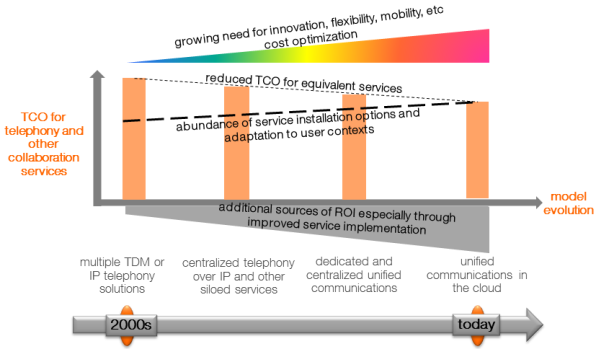What motivates companies today to transform their collaboration solutions? Why is total cost of ownership (TCO) such an important factor? How exactly is it calculated? And what about cloud-based unified communications? Are they really an effective way to optimize return on investment (ROI) and TCO?
controlling and optimizing costs: the crux of the matter
Companies are eager to upgrade their collaboration services and solutions for a variety of reasons, including:
- innovation
- agility
- streamlined collaboration inside and outside the company or when traveling
- standard and speedy services
- image and reputation (being the “place to be”)
- improved working conditions
- productivity
Among the reasons for making the switch, there’s ONE that comes up in every single business survey, regardless of sector or size: controlling and optimizing costs. In fact, it’s the common challenge faced by every business on a daily basis!
Businesses want to make their investments more predictable and they clamor for ways to optimize operating expenses (OPEX). Cloud collaboration has demonstrated that it can improve ROI, thereby providing businesses with an added bonus.
did you say TCO?
TCO is an extremely useful decision-making tool, as long as you use it correctly.
To assess the full financial impact of any transformation project, you’ll need to calculate the TCO of your current solutions and services and then compare it with the TCO of your target solutions over a given period.
The following chart shows a sample TCO structure for a unified telephone and communications solution. The final goal is to identify all investment costs (CAPEX) and recurrent costs (OPEX) and then chart these costs over time.
To simplify your analysis, you can use this data to calculate the average cost of the solution per user and per month.

TCO components for a unified communications solution (source : Franck Lamalle - Orange Consulting)
first, start your analysis with a solid foundation
Any time you need to calculate TCO, you first have to choose a reliable operating method and distance yourself from old methods of comparison.
Therefore, you’ll need to:
- define the right hypotheses for your calculations
remaining value of initial investments, duration of current service contracts, amortization period, staggering of transformation period, complete scope and frames of reference for comparison (for example: a user, a job, a conference room, etc) - track down hidden costs
1. in the current situation: investment and risk tied to out-of-date solutions, maintaining expertise and real management costs for each solution, telecom and communications costs (especially when these services aren’t centralized and are poorly understood by companies), etc.
2. during the transformation: transition and change management for users and support teams, impact on IT systems, etc. - avoid comparing apples and oranges
transformation projects related to collaboration don’t generally aim to maintain the status quo but rather offer new features or services. This means the project will not necessarily lower the final TCO. In addition, many businesses only have a partial understanding of current TCO or lack the resources to perform a truly objective comparison - choose an appropriate scope for analysis, as your TCO will depend upon it
comparing different models of the same solution or service for 1,000 users will not yield the same results when simulated for 20,000 users
next, how do I optimize my solution?
after IP convergence: unifying collaboration tools to optimize TCO…
IP transformation provides an initial level of centralization for telephones and video services (among others). The only problem: most of the time, all these IP services are structured in silos, both in terms of installation and management!
Fixed and mobile telephones; message systems; audio, web and video conferencing; telepresence and related services mostly operate independently of each other, with some overlap between solutions that are especially difficult to combine. In addition, it’s not uncommon for solutions offered by different providers to coexist within the same company for the same service.
In the long run, upgrading to a global unified communications solution can generate economies of scale and thereby lower TCO in terms of:
- operational costs, by simplifying management processes for changes, configurations, maintenance, etc
- hardware and software costs
1. by consolidating infrastructure
2. by integrating multi-device functionality (mobile devices, PC) and reusing them. For example, some groups may prefer to use a unified client and/or softphone instead of a landline - build services, by simplifying installation processes and shortening production cycles
- telecom costs, by continuing IP convergence to provide:
1. lower costs for off-net and roaming traffic by equipping digital nomads with softphones, integrating audio conferencing services over IP, etc.
2. improved cost visibility by centralizing traffic access fees to limit the number of providers, especially on the international scale, through services such as SIP trunking
and finally, tailoring the service to optimize TCO
Compared with integrated and hosted services, unified communications services in the Cloud provide extra flexibility. This demand for more flexibility first came from consumers and then grew to businesses in the form of “pay per use” services. The model makes it a lot easier to launch your transformation and rapidly meet needs for new services in both qualitative and quantitative terms without having to invest a lot at the outset. In practical terms, this means you can innovate and provide new uses while spending a lot less energy doing so.
By reducing capital expenditure, migrating to the cloud gives IT departments more control over TCO and allows for more efficient management of financial risks. As a result, IT departments can stay focused on developing their service catalog and meeting their clients/co-workers’ increasingly sophisticated and volatile needs.
any additional sources of ROI to top it all off?
While the cost structure for cloud services makes it easier to transform collaboration services, the potential to highlight new ROI sources can make the decision even easier from a business perspective.
Below are some areas of potential ROI depending on which services are to be installed and the project’s context:
- transportation costs: lower travel budgets since some business trips will no longer be necessary
- operational costs: optimized resources and budgets by increasing telecommuting and combining certain positions
- better time management: improved communications and increased availability by eliminating some business trips
- business gains: accelerated project schedules, improved client response times, better external brand image, increased talent attraction and retention
Of course, potential ROI from these sources can only be achieved if these services are actually used. Employees generally do use these services since they’re flexible, interconnected, innovative, multi-device and adapted to the needs of actual users.
in conclusion, nothing is better than one last chart and a few final words

TCO structure for a unified communications solution - source: Franck Lamalle
To sum up, we’re already progressively seeing:
- an increasingly significant role played by collaboration tools and in turn, a growing demand for these tools to contribute to business challenges including cost optimization
- new service models for IP convergence, unification and the Cloud, all of which bring:
1. lower TCO for collaboration tools
2. more sophisticated and adapted services for users
3. easier methods to pinpoint sources of ROI
Franck Lamalle
This post was originally published in French here.
image © shockfactor - Fotolia.com

As a manager in Orange Consulting, the consulting entity of Orange Business, I am in charge of a team of consultants helping our customers manage their digital transformation projects. I have more than 15 years experience in network and infrastructure services, unified communications, IP Telephony and videoconferencing in multiple delivery modes (integrated, managed or cloud). I aim to keep customer and user satisfaction by always providing advice with a spirit of pragmatism and innovation.